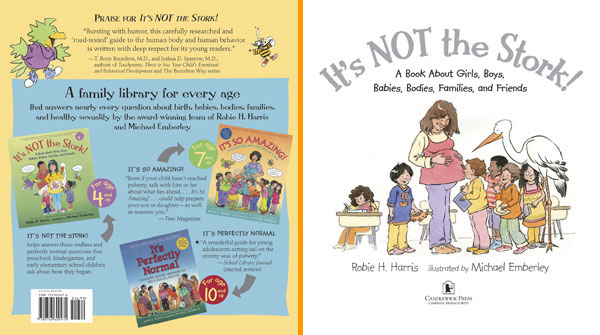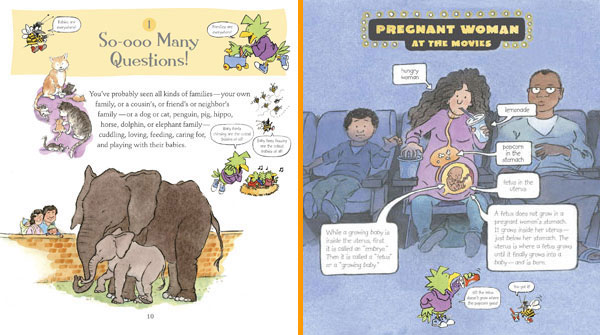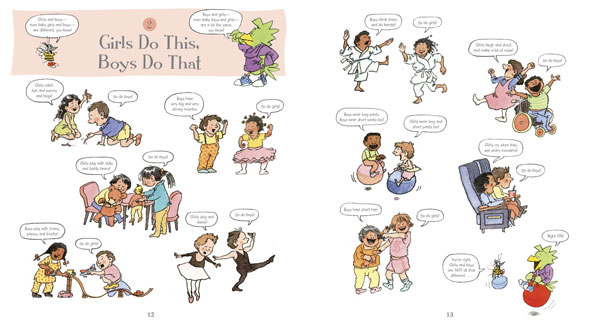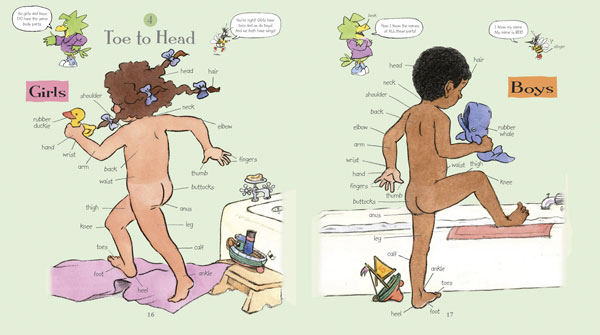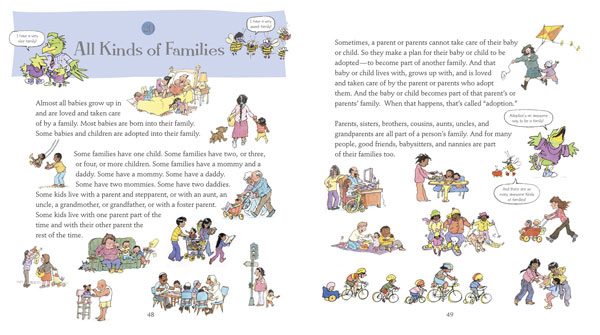Candlewick Press, August 2006
Illustrated by Michael Emberley
Our young children are curious about almost everything. They are especially curious about their bodies, about where they came from and how they were made. Many, but not all, ask us endless questions about these topics. They ask us why their bodies are the same and different from other peoples’ bodies, what makes a girl a girl and a boy a boy, what the names are of all the different parts of their bodies, where babies come from, how babies are made, what a family is — and so many other questions about themselves and their bodies. Many of their questions are easy to answer. Others are more difficult to answer. Michael Emberley and I created this book to answer young children’s many questions and concerns about these issues. We talked with parents, teachers, librarians, nurses, doctors, social workers, psychologists, scientists and clergy to make sure that all of the material in this book is comfortable, reassuring, age-appropriate and scientifically accurate.
This book, written especially for four, five, and six year olds, is the book to reach for when the questions begin — young children’s questions about where babies come from and what makes a girl and girl and a boy a boy. With the publication of this book, children of all ages and their families have a library of books — It’s Perfectly Normal for children age 10 and up; It’s So Amazing! for children age 7 and up and now, It’s Not the Stork! for children age 4 and up.
 “In their previous landmark volumes It’s Perfectly Normal and It’s So Amazing!, Harris and Emberley established themselves as the purveyors of reader-friendly, straightforward information on human sexuality for children as young as seven. Here they successfully tackle the big questions about body parts (in successive chapters called “What Boys Have” and “What Girls Have”), where babies come from, and other related issues for even younger kids. The ever-curious cartoon bird and his more reticent bee friend, first introduced in It’s So Amazing!, set a welcoming tone right from the beginning, when, in a double-page comic-strip spread, they see a baby hippo at the zoo and wonder about its origins. Using basic yet thorough explanations, the text then proceeds to inform the duo that babies don’t grow in gardens or get ordered over the Internet. Emberley’s relaxed cartoon depictions of children and grownups with a realistic array of body types work seamlessly with the text to illustrate everything from anatomy to fetal development to different configurations of families. One useful and particularly humorous illustration titled “Pregnant Woman at the Movies” exemplifies the book’s attention to detail. A mixed-race family — white mom, black dad, son, and baby in utero — sit in their seats at the theater while labels pointing to the mother’s middle distinguish between the stomach and the uterus, clearly showing children that “the fetus doesn’t grow where the popcorn goes!”
“In their previous landmark volumes It’s Perfectly Normal and It’s So Amazing!, Harris and Emberley established themselves as the purveyors of reader-friendly, straightforward information on human sexuality for children as young as seven. Here they successfully tackle the big questions about body parts (in successive chapters called “What Boys Have” and “What Girls Have”), where babies come from, and other related issues for even younger kids. The ever-curious cartoon bird and his more reticent bee friend, first introduced in It’s So Amazing!, set a welcoming tone right from the beginning, when, in a double-page comic-strip spread, they see a baby hippo at the zoo and wonder about its origins. Using basic yet thorough explanations, the text then proceeds to inform the duo that babies don’t grow in gardens or get ordered over the Internet. Emberley’s relaxed cartoon depictions of children and grownups with a realistic array of body types work seamlessly with the text to illustrate everything from anatomy to fetal development to different configurations of families. One useful and particularly humorous illustration titled “Pregnant Woman at the Movies” exemplifies the book’s attention to detail. A mixed-race family — white mom, black dad, son, and baby in utero — sit in their seats at the theater while labels pointing to the mother’s middle distinguish between the stomach and the uterus, clearly showing children that “the fetus doesn’t grow where the popcorn goes!”
-The Horn Book, September/October 2006
 “Harris opens by introducing two cartoon characters — a green-feathered bird clad in a purple shirt and blue high-top sneakers and his spike-haired friend, a bee. They wonder, “So where DO babies come from?” their conversational commentary, given in word balloons, is a lighthearted supplement to a more focused narrative. Told in the second person, the text is straightforward, informative, and personable. Facts are presented step-by-step, starting from the similarities and differences between boys’ and girls’ bodies, moving to a baby’s conception, growth in the womb, and birth, ending with an exploration of different configurations of families as well as a section on “okay” versus “not okay” touches. The book is logically organized into 23 double-page sections. Friendly and relaxed cartoons, either interspersed with the text or appearing in comic strip form, are integral to the title’s success in imparting the material. The labeled drawings show both the outside and inside parts of the body. As the bee and bird say to one another, “Knowing the names of ALL the parts of your body is — PERFECTLY NORMAL!” Overall, this book will be accessible to its intended audience, comforting in its clarity and directness, and useful to a wide range of readers.”
“Harris opens by introducing two cartoon characters — a green-feathered bird clad in a purple shirt and blue high-top sneakers and his spike-haired friend, a bee. They wonder, “So where DO babies come from?” their conversational commentary, given in word balloons, is a lighthearted supplement to a more focused narrative. Told in the second person, the text is straightforward, informative, and personable. Facts are presented step-by-step, starting from the similarities and differences between boys’ and girls’ bodies, moving to a baby’s conception, growth in the womb, and birth, ending with an exploration of different configurations of families as well as a section on “okay” versus “not okay” touches. The book is logically organized into 23 double-page sections. Friendly and relaxed cartoons, either interspersed with the text or appearing in comic strip form, are integral to the title’s success in imparting the material. The labeled drawings show both the outside and inside parts of the body. As the bee and bird say to one another, “Knowing the names of ALL the parts of your body is — PERFECTLY NORMAL!” Overall, this book will be accessible to its intended audience, comforting in its clarity and directness, and useful to a wide range of readers.”
-School Library Journal, September 2006
 “…Emberley’s affectionate, mood-lightening cartoons keep things approachable, while Harris’ respectful writing targets children’s natural curiosity without cloaking matters in obfuscating language… a sensitive entrée to the facts of life that will adapt to individual families who share the view that, when teaching kids about bodies and babies, honesty is the right strategy.”
“…Emberley’s affectionate, mood-lightening cartoons keep things approachable, while Harris’ respectful writing targets children’s natural curiosity without cloaking matters in obfuscating language… a sensitive entrée to the facts of life that will adapt to individual families who share the view that, when teaching kids about bodies and babies, honesty is the right strategy.”
-Booklist, June 2006
“What a joyous world Robie Harris and Michael Emberley have created for learning about everyone. First, they enchanted us with It’s Perfectly Normal, a welcome guide for young adolescents about what’s happening to their bodies, and It’s So Amazing!, an illustrated educational resource, for those wonderfully curious people aged seven to 12 years old. Now they give us It’s NOT the Stork, which answers “the perfectly normal” questions of children ages four to seven in a celebration of life from birth to old age.
It’s difficult to measure the importance of the vision of open communication about sexuality that Harris and Emberley have achieved. It’s their winning combination that charms: Harris’ meticulous research and understanding of children’s development and Emberley’s delightful illustrations that include people of all varieties. As a grandmother, I especially appreciated the grandma in shorts with a golf club, rather than in a rocking chair. Yes, absolutely, this book is a treasure trove for parents. For many, it will be a great relief — a joyful and accurate way to open communication with their children. Somehow Harris gets things just right: first a trip to the zoo filled with questions. Next a section, “So-ooo Many Questions!” encouraging children to ask away. Then wonderful pages showing all the things both boys and girls can do: “Boys can climb trees and do karate!” “So do girls!” “Girls cry when they see scary monsters!” “So do boys!” Next come the differences — beginning, of course, with how they use the toilet. Drawings of the backs of a naked boy and girl name all those body parts that are the same; drawings of the fronts show the differences, including a vulva that identifies a clitoris and explains: “girls and women have three openings between their legs … ” Harris’ genius is her ability to make the complex simple, to answer incipient questions with a few key facts and to resolve the mysteries, e.g., changes that happen at puberty. Meanwhile, Emberley’s illustrations show delightfully average and not model type girls and women, boys and men at six stages of life. On they go, explaining sperm and eggs, a “special kind of loving called ‘making love,’ ‘having sex,’ or ‘sex’ … when the woman and man get so close to each other that the man’s penis goes inside the woman’s vagina.’” Oh! I predict some parents may skip a few words here and fast-forward to the fascinating picture of the pregnant woman in the movies which shows the popcorn in her stomach and the fetus in her uterus! Or, to the actual size pictures of the embryo and the fetus up to nine months. Next comes the joy of the birthday, a celebration of different kinds of families, a savvy description of “Okay Touches, Not Okay Touches,” and finally an accolade to “Growing Up.” The feisty conversations of the curious bird and reluctant bee that delighted adults, as well as children in the two earlier books, continue their playful/serious commentary throughout It’s NOT the Stork! What a brilliant way to validate questioning, not knowing, and searching for information.
Bird: “So-ooo, a baby, comes from a STORK???”
Bee: “I don’t THINK so!!!”
Bee: “Knowing the names of ALL the parts of your body is —”
Bird: “PERFECTLY NORMAL!”
The Harris/Emberley books provide an important vision of a comprehensive sexuality education. Even if you have no children or grandchildren, buy one for yourself�enjoy it, laugh with it and pass it on to nieces, nephews, friends … Every child deserves an opportunity to wander through these pages, doubtless to return again and again, so very lucky to find clear answers to fundamental questions that many puzzle about for years.”
-Peggy Brick, MEd., Contemporary Sexuality, June 2007, Vol. 41, No. 6
“A breathtaking amount of research went into the creation of this child’s first book about sex. Several years in the making, it is a masterpiece of combining an age-appropriate amount of information in a way that is inviting, upbeat and clear. This book has no agenda other than to present accurate information about our bodies and, ultimately, how babies are made.
Beginning with acknowledging that there are many ways in which girls and boys are the same, it goes on to talk about and illustrate the ways in which they are physically different—both externally and internally. Smoothly and in a way children can understand, the topic segues into how those differences make it possible for eggs and sperm to be produced, why they exist, and how a baby begins and is ultimately born. The book touches on other issues any child can encounter and any curious child can be expected to wonder about—C-sections, multiple births, circumcision, adoption, foster parents, stepparents, “okay touches” and “NOT okay touches”—and does so with graceful and simple aplomb.
It’s NOT the Stork! offers a solid foundation upon which our children can feel knowledgeable and comfortable about their bodies. Approved by science, health and child-development experts, it is a classic in the making. Robie Harris and Michael Emberley have created the perfect book for curious children (and what children aren’t curious about their bodies, where babies come from, etc.?) and their parents. As far as we’re concerned, it belongs in every home!”
-Chinaberry
“Where do babies come from? This perfectly normal question makes some parents squirm. But help is on the way with an honest answer in the amazingly clear and comprehensive “It’s Not the Stork” written by Robie H. Harris and illustrated by Michael Emberley.
Some young kids will pour over every tidbit, cover to cover. After all, this subject has sex appeal. Other kids will cruise around the short chapters checking out the hilariously instructive cartoons and assiduously labeled diagrams. (Bodies are viewed front and back.)
For some kids, the book offers a venue for shared experience with parents or peers. And, certainly, adults will gratefully draw on the book’s frank language and friendly tone when talking things over with their kids in the car or at the zoo.
The creators of the award-winning “It’s Perfectly Normal” (1994) and “It’s So Amazing” (1999), aimed at teens and ‘tweens respectively, this time offer an introductory course on the birds and the bees for a younger audience, with the now familiar Bird-and-Bee exchanging disarming banter along the way. On learning about the uterus, Bird concludes, “So the fetus doesn’t grow where the popcorn goes!” Replies Bee, “You got it!”
This must-have family resource addresses all kinds of such funny misconceptions, supplying instead the real facts of life. Carefully vetted by science, health and child development experts, everything is correct as correct can be—information about gender differences, reproduction, different kinds of families and different kinds of friends. And it is surprisingly inclusive, gracefully touching on such topics as in-vitro fertilization, same-sex parents and adoption.
Living in an age when preschoolers are likely to encounter ads for Viagra on radio and TV, “It’s Not the Stork” is especially welcome. When it comes to sex, kids need information that is reassuring, accurate, up-to-date and age-appropriate. And that surely means finding out about function before having to find out about dysfunction.”
-Susan Faust, The San Francisco Chronicle, October 29, 2006
“If it’s not the stork, where do babies come from? Does mommy swallow a watermelon seed? Does daddy buy a bag of seeds, plant then in the garden and then mommy picks the baby she wants off the resulting vine? Does daddy order one on-line? Or does a stork drop a baby down a chimney to be caught by the expectant parents? No, no, no and gently no, are the answers, in this fine introduction to the birds and bees, one well-laced with humorous illustrations and diagrams that convey information as well as maintain the cheerful, even exuberant, “it’s perfectly natural” tone of this book.
It’s a book that pulls no punches about body parts and functions, and one of its virtues is that it names things for what they are and doesn’t shrink from calling a poo a poo; the vernacular is an effective means of communication for this intended audience. Some of the areas of sexuality and family life explored are insemination, pregnancy—from “pinpoint to watermelon”—the birth process, a variety of different models of family life, and touching that’s okay and touching that’s not.”
-Toronto Globe & Mail, October 7, 2006
“What’s the “right” age at which to introduce information on human reproduction? Harris agrees that’s for individual families to decide, and to give an assist to parents who feel “the younger, the better,” she has abridged her presentation from It’s So Amazing for an even younger audience. Adults familiar with Amazing will note that the format remains pretty much the same, right down to the curious cartoon bird and reticent bee that trade quips on their newly acquired knowledge; language, however, is slightly simplified and tidbits of information are deleted (topics such as masturbation, homosexuality, and types of twins are introduced, but they receive less detailed treatment) to shorten the text by some twenty pages. Emberley’s cartoon cast, a celebration of demographic diversity, do double duty as helpful diagrams of body parts and fetal development, and as examples of loving families in action. The developmental bridge between this title and Amazing is considerably shorter than the span between Amazing and Perfectly Normal, and although public libraries will certainly want to offer all three works, families looking for that one good book for their preschoolers might just as well trade up a level to Amazing for more complete information, and customize their readalouds to suit their own children’s needs.”
-Bulletin of the Center for Children’s Books, October 2006
“If you already own Harris and Emberley’s previous titles, “It’s So Amazing!” and “It’s Perfectly Normal,” then you won’t hesitate to add their newest title to your family library. Robie Harris is unique in her ability to provide straightforward, reassuring answers to the questions children have about their bodies, sexuality and growing up, in straightforward, reassuring manner. In a respectful voice and with age-appropriate language, “It’s NOT the Stork!” helps answer those endless questions preschool, kindergarten and early elementary school children wonder about and often ask, such as, “Where do babies come from?” and “What makes a girl a girl?”
Cartoon drawings illustrate the text and include two characters, (curious) Bird and (embarrassed) Bee, who offer humorous and clarifying asides. Vetted by trusted child development experts including T. Berry Brazelton, M.D. and Penelope Leach, Ph.D., the information is scientifically accurate and up-to-date. This is the book to reach for when the questions begin.”
-Parent’s Express, August 15, 2006
It’s NOT the Stork! helps parents explain
“One college memory that still cracks me up was the night a roommate innocently revealed incomplete knowledge about her own body and reproduction. And she was the only one of us who had a steady boyfriend. She wouldn’t have embarrassed herself if she had read Robie Harris’ new picture book “It’s NOT the Stork!”. Harris does an enormous favor for any parent who becomes tongue tied when trying to explain biology and babies. The subtitle just about says it all: “A Book About Girls, Boys, Babies, Bodies, Families, and Friends.” “It’s NOT the Stork!” is pure sterling. Harris, a former teacher, burst into the picture-book world in 1994 with “It’s Perfectly Normal,” a fun, fact-filled presentation for ages 10 to 13 about growing up and puberty. Five years later, she wrote “It’s So Amazing,” a fact-based narrative about the complicated science of eggs, sperm, babies and bodies for ages 7 to 10. Both have won national awards, and both have weathered challenges from communities unhappy about a frank, graphic approach to knowledge about sex. Harris’ new book is perfect for the pre-schooler who’s asking where he or she came from and about the differences between a boy and a girl. Even parents comfortable talking about one’s “privates” and human biology will appreciate Harris’ relaxed, humorous approach and her silly sidekicks, Bird and Bee. Without blinking, Harris covers her subject from head to toe. She uses authentic names to point out arms, legs, elbows and privates. The parts are shown on boys and girls depicted in colorful, perky drawings by Michael Emberley. His illustrations of how the sperm and eggs get together includes an algebraic equation, a smiling couple under the covers and a pink sea of tadpolelike sperm swimming to the egg. Beyond body parts, gestation, birth and bellybuttons, Harris describes all kinds of “awesome” families, such as those with one mom or dad, two moms or dads, adoptive parents, foster parents and grandparents. In the concluding chapter “Okay Touches, Not Okay Touches,” she empowers children to say “no.” No family with young children (or naïve young adults?) should miss this one.”
-Sacramento Bee, July 23, 2006


